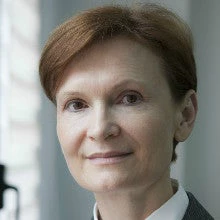They say a picture is worth a thousand words. Such is the case with this image of Aina Jakypova, a math teacher from a Kyrgyz village, explaining percentage calculations on the front gate of her home. When the COVID-19 (coronavirus) pandemic disrupted education in the Kyrgyz Republic, as it did around the world, Ms. Jakypova understood all too well that her students would suffer learning losses as a result of school closures. This was especially true for schoolchildren from poor families, who are likely to suffer losses in learning equivalent to almost a half year of schooling. The video went viral in the Kyrgyz Republic, but its relevance and meaning extend far beyond.
We must acknowledge that education and learning have changed as a result of the pandemic. Remote learning has underlined that many current teaching methods and learning approaches are outdated. Reciting memorized texts or responding to factual questions that can easily be looked up online will no longer suffice. Instead, critical thinking, problem solving, and self-management must take a front seat, as it were, with digital skills at the steering wheel.
The COVID-19 crisis threatens to widen existing learning gaps. In better-off families, children and young people have the space to work, the requisite technology, an internet connection, textbooks, and other school supplies. The same is not always true among vulnerable families, whose children’s learning opportunities are particularly affected. In Kazakhstan, the OECD’s Programme for International Student Assessment (PISA) 2018 results showed that students with access to computers were 20 points ahead of their peers with no such equipment available. Similarly, students with access to computers and the internet were roughly a half year ahead of those without this technology.
The COVID-19 pandemic has demonstrated that we cannot adequately prepare children for the future of learning without first ensuring equality of opportunity. This is why it is so important that the issue of equity in education remains at the top of government agendas as they plan their learning recovery strategies.
Creativity also involves partnerships. In Central Asia, there have already been some excellent examples of public-private partnerships in education in response to the pandemic. In Kazakhstan, for example, mobile operators have teamed up with the national telecom operator and the Ministry of Education and Science to provide families with free internet access to over two dozen educational resources. Another partnership between the ministry and the national post service, Kazpost, is helping to deliver education to 20,000 students living in remote areas. Similarly, in the Kyrgyz Republic, mobile operators helped students and teachers get free access to education apps and web pages, and to communicate via WhatsApp messenger.
Education systems need to be more resilient in the face of future adversities, since we simply cannot afford the long-term losses in human capital that result from such shocks. This kind of resilience will require a considerable upgrading of the education sector and substantial resource investments.
Countries in Central Asia have demonstrated significant adaptability in responding to the COVID-19 pandemic. Uzbekistan and other countries in the region focused on equity, ensuring that children without an internet connection at home can access education via broadcast television. Kazakhstan has deployed a mixture of channels, organizing both the private and public sectors to deliver schooling to the most remote and vulnerable. In addition to existing resources, the Kyrgyz Republic is looking to deploy external resources, such as teaching materials from other countries.
Going forward, we need to look more closely at the implementation of remote learning across Central Asia in order to understand what went well and what needs to be improved. This would provide crucial information on the impact of distance learning, thereby enabling countries to build more effective and productive education systems.
At the World Bank, we are already helping Kazakhstan with this monitoring effort and will be sharing the results in the months to come. Other support includes a review of ongoing Bank-financed education projects to make emergency funding available through, for instance, the Education Modernization Project in Kazakhstan, or the launch of the Learning for the Future Project in the Kyrgyz Republic.
The COVID-19 pandemic is more than a health emergency—it is a full-blown crisis that is affecting almost every aspect of people’s lives. Although we have yet to see its full impact on human capital in Central Asia and beyond, we nevertheless need to act urgently to minimize the learning losses, especially among the most vulnerable. We must also ensure that we rebuild our education systems to perform even better for future generations.
I hope that we can all learn from the math teacher Aina Jakypova. Standing in the direct sunlight, with nothing but a piece of chalk in her hand, she taught more than percentage calculations. She demonstrated both the need and ability to be flexible, creative, and resilient.



Join the Conversation